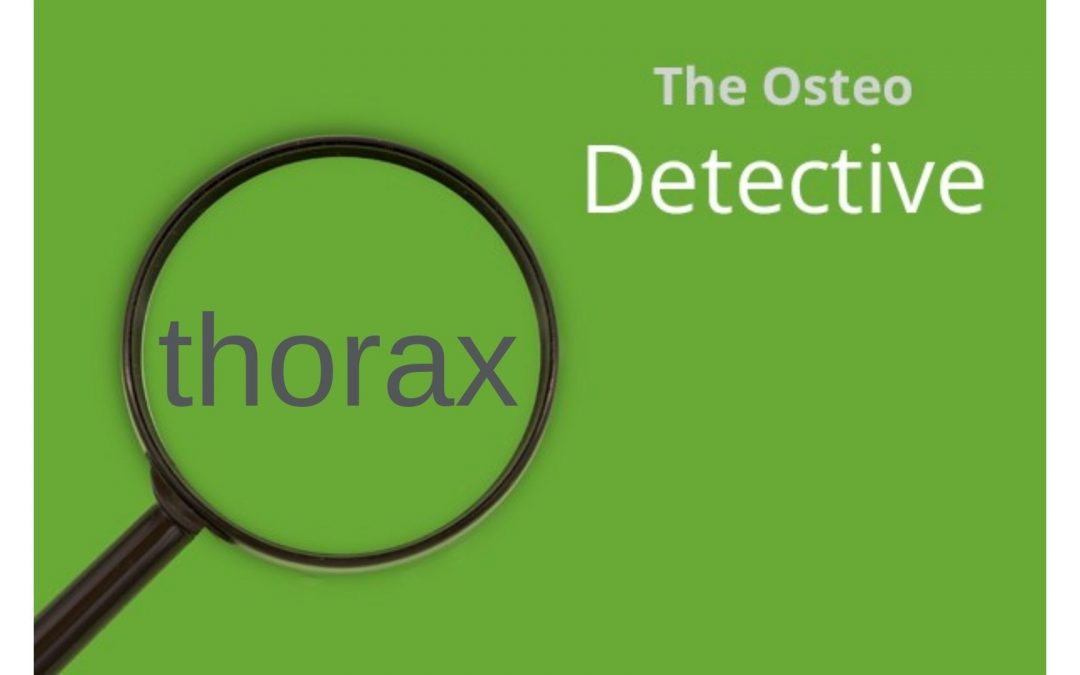The thorax is the whole trunk of our bodies between the base of the neck and the top of the abdomen. Place a finger in the little hollow where it seems your collar bones almost meet in the middle. That’s the top boundary of the thorax. Now gently press your fingertips in underneath the bottom of your ribs. That’s where the thorax ends and the abdomen starts.
What’s in there? Well, it’s the important bits. Heart and lungs. They’re protected by the rib cage and breastbone which act as a suit of armour. Ribs also help with breathing though so it’s not a rigid cage. The ribs have joints and they need to be able to move up and down. The thoracic spine runs down the back of the cage creating a channel for the spinal cord to run down to the lower parts of the body with special exits for nerves supplying the internal organs.
Osteopathy can be so fascinating. Hold on tight, here comes the anatomy and neurology lesson.

The spinal column is divided into separate bones, the vertebrae. There are nerves coming out of the special gaps between the spinal bones and as they emerge from these gaps, they split into 2 branches. Those two branches each have a different job. One branch deals with the parts of the body we’re more consciously aware of, and the other with things that are more automatic and subconscious. A good example of that split would be nerves that we use to lift a leg or flex a foot and nerves that make our gut work to help digest things. They come out of the same hole in the spine; one of them you can tune into and consciously change, the other goes on in the background without any conscious input.
On occasion, because these nerve branches are coming out of the same exit from the spine, and feeding messages back in to the same entrance, the brain can get confused. So sometimes we feel pain in a place unrelated to where the problem really is.
How does this relate to the thorax?
Let’s say you’ve come in to see me with a bit of pain round the front of your chest and down your arm. You tell me you spent yesterday in the garden and sawed up some old branches. My job when people tell me their symptoms is to do what’s called a ‘differential diagnosis’. It’s always annoyed me a bit that this has a confusing name. Differential diagnosis just means that I have to run through in my mind all the possible things that could cause your pain.
You’re probably ahead of me here, but let’s just go back again to the idea that messages being sent into the spinal cord and up to our brain can get confused. Is the pain in your arm and chest just what it seems? You were gardening yesterday so that’s the most likely thing.
But some of the nerves that come away from your heart enter the spinal column at the same place. So these are also symptoms of a possible heart attack. I’m not trying to frighten you (or myself)! This is just a really good example of the detective work that I need to do in my clinic.
Before I treat you for thoracic pain I have to think about heart attack, chest infection, shingles, stomach acid and many other possibilities to go into my differential diagnosis. Once I’m satisfied that I don’t need to send you on to your GP I can concentrate on the Osteopathic questions I want to ask.
Are your ribs moving well so that you can breathe easily and get the oxygen you need.
Did you strain a muscle coughing?
Do you have the strength and co-ordination you need to get that golf swing better?
Is your upper body posture being affected by loads of computer work?
It’s no wonder that Osteopaths focus on this part of the body whether it hurts or not. We’re always doing a bit of detective work to make sure all is well. Getting movement and posture working well around the thorax is a fundamental part of good health.

